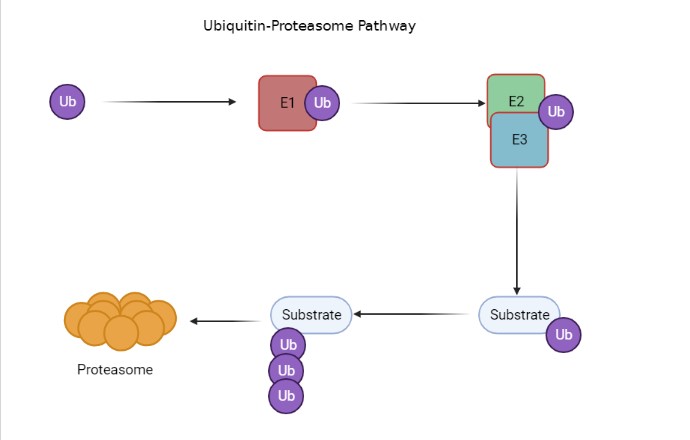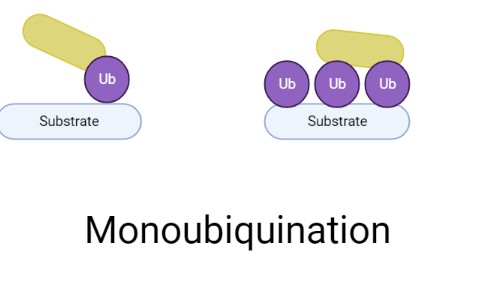Discovered in 1975 by researchers led by Gideon Goldstein. Ubiquitin was found by research that was funded to characterize proteins and associated processes. Aaron Ciechanover, Avram Hershko, and Irwin Rose extended Ubiquitin's acknowledgment by relating it to cell cycle control of biological processes, including gene transcription and immune functionalization. Ubiquitin is a small protein modifier in the sense that it is more associated with being a post-transitional modifier. On a general basis, Ubiquitin is found in tissues of humans and eukaryotic organisms. It is well known for the role that it plays in protein apoptosis. It is commonly known as the “kiss of death” for proteins in the body even though Ubiquitin is primarily associated with adjusting proteins in binding and functions. Ubiquitin is found in the nucleus and can be seen in the cytoplasm and cell surface membrane. Ubiquitin can handle a spectrum of pH ranges and can also resist tryptic digestion.
Function
The more common function of Ubiquitin is the degradation of proteins through the proteasome, the proteasome is an organelle of digestion, it is a protein complex in cells that houses proteases, proteases break down proteins that have been marked and tagged by Ubiquitin. Similarly related to lysosomes which break down cytoplasmic components, including proteins and defective organelles. Ubiquitin is notably known for protein degradation via the Ubiquitin-Proteasome pathway, in eukaryotic cells, Ubiquitin is used as a marker that aims for cytosolic and nuclear proteins for degradation. Ubiquitin is a polypeptide that is found in nearly all eukaryotes. Proteins are marked and tagged for degradation by Ubiquitin through a lysine residue. More Ubiquitin is added to complete a multiubiquitin chain. Any polyubiquitinated protein that Ubiquitin has already tagged is added, sensed and recognized by a subunit protease complex that will degrade the polyubiquitinated protein. After such a process, Ubiquitin is released to be reused again in another cyclic cycle. All of the processes that were previously mentioned require ATP to happen.
The Proteasome System
In the proteasome system there is a 26s proteasome that is widely regarded as the proteolytic machinery with Ubiquitin. The system congregation has 19s subunits on both sides of its 20s subunit. The 19s complex encompasses ATP activity at its core to allow for the unfolding of protein substrates into the central canal of the 20s proteasome. The proteasome itself is barrel shaped with four stacked rings, two outer alpha and two outer beta rings that are formed by seven subunits. The alpha ring's purpose is to maintain itself as a gatekeeper of the proteolytic core. The 20s proteasome complex degrades misfolded and oxidized proteins without ubiquitination. However, a certain route of ubiquitinated proteins to the proteasome allows the 26s proteasome to readily recognize polyubiquitinated proteins. The ubiquitin aspect itself is heavily involved in the regulation of the number of cell pathways.

Ubiquitination
Ubiquitination is the formal term for: “kiss of death” protein process, with the use of ubiquitination, a protein can become inactivated when ubiquitin is attached to it. Through a multistep process, Ubiquitin is activated by attaching to the ubiquitin-activating enzyme (E1). Ubiquitin will transfer onto another enzyme called ubiquitin-conjugating enzyme (E2). After being transferred to the ER, Ubiquitin is mediated by a third enzyme called ubiquitin ligase (E3) and directed to the target protein. Most cells have an E1, but in some cases the Ubiquitin can be transferred from E2 to the target protein by forming a complex with E3 in the same process. Monoubiquitination associates when a single ubiquitin protein binds to one protein substrate, this type of ubiquitination deals with cellular processes like receptor modulation, endocytosis and viral infections. In yeast and mammals monoubiquitination is important for signaling for cell surface proteins into the endocytic pathway. As proteins are delivered to the lysosome for destruction, it can be used to sort transmembrane proteins into vesicles that associate into the lumen of an endosomal compartment. Transport signals that were created by monoubiquitin are acknowledged by ubiquitin-binding components that allows for vesicle budding. Polyubiquitination happens when there is a chain of ubiquitin molecules on a single long lysine of a substrate protein. This type of ubiquitination deals with immune and inflammatory response and DNA translation/repair.

Deubiquitination
Just like ubiquitination there is another process called Deubiquitination, proteases involved in this pathway called Deubiquitinating enzymes cleave Ubiquitin and Ubiquitin like proteins from proteins or target proteins. The overall process involves deubiquitinating enzymes going forward with activation of ubiquitin pro-proteins. Ubiquitin is also expressed as a pro-protein that is fused to ribosomal proteins. The polyubiquitin product also has another residue at its C terminus that has to be taken off in order to fully activate the Ubiquitin. Another point is that deubiquitinating enzymes recycle Ubiquitin when small nucleophiles have trapped the Ubiquitin. Deubiquitinating enzymes can also reverse the ubiquitination of target proteins, from this action deubiquitinating enzymes act like a phosphatase in regulatory pathways. Deubiquitinating enzymes are meant to regenerate monoubiquitin from unanchored/unbounded proteins.
Structure
Ubiquitin is composed primarily of alpha helices and beta-pleated sheets. An important structural component is the C terminal tail that is important for covalent conjugation onto substrates. Ubiquitin itself contains 76 amino acids and has a molar mass of around 8.6 kDa. On top of that the main structure has a C terminus tail and 7 lysine residues. Ubiquitin has a hydrophobic core, three hydrophobic residues on the alpha helix and eleven hydrophobic residues on the beta sheet. The main reason Ubiquitin is stable is because of the many hydrogen bond interactions in the structure, this implies that Ubiquitin goes through many hydrogen bonding actions. The E2 and E3 complexes have an interesting structural composition, they are crystal structures that allows for E2 to make physical contact with E3 through side chains at the C terminal end of the E helix, more specifically the place where the loop that connects B strands one and two at the farthest end of the active site loop. As for the contact between E1 and E2, contact is associated with Ubc9 with the E1 being controlled by the C terminal end of the Ubc9 helix and the loop between B strands one and two. Ubiquitin-like protein modifiers differ from Ubiquitin by structural components. Attaching ubiquitin-like protein modifiers makes a protein surface topography at the unmodified protein. This can inhibit the binding of protein to another molecule and affect enzymatic activity. There are ten different ubiquitin-like protein modifiers in mammals. The E2 and E3 complex consists of about 212 sequences and sulfate, zinc, sodium, and ammonium ions just to name a few. The E3 complex conjoins with a Lys48 linked chain of Ubiquitin to target the substrate for degradation by the Ubiquitin-Proteasome pathway. When Ubiquitin binds to the E1 complex it does that with a thioester bond after ATP hydrolysis, the Ubiquitin will then be transferred to a cystein residue active site in the E2 complex. There are three types of E3 complexes, there is a E3 complex called: “RING E3s” which operate as a structure to make E2 and its substrate within closer proximities. The other version is called “HECT E3s” which forms an intermediate thioester connection with Ubiquitin before the ubiquitin begins to move to the substrate.
Diseases Associated with Ubiquitin
Ubiquitin has its benefits and costs when it comes to diseases, namely so, Ubiquitin is related with the pathogenesis of diseases, while on the other side it can be used as a biological marker. Neurodegenerative diseases are more closely associated with the dysfunctions of Ubiquitin. Ubiquitin can form covalent bonds with protein in order to mark them for degradation through the ubiquitin-proteasome pathway, when cells that Ubiquitin marks are not broken down properly, homeostasis is unbalanced and this could potentially lead to pathogenesis. Isoforms of Ubiquitin have been found in Alzheimer’s and Parkinson’s disease. High levels of Ubiquitin are believed to decrease the malformation of amyloid precursor protein, a key indicator for Alzheimer’s disease. Low levels of Ubiquitin can lead to the increase of amyloid precursor protein malformation. Ubiquitin B changes can also lead to a lack of C-terminal glycine in peptides, which is also believed to aid in neurodegenerative disease pathogenesis.
Diseases correlated to Ubiquitin are associated with encoding ubiquitin ligase (E3), the interference of this encoding process can directly lead to Angelman syndrome. Symptoms of Angelman Syndrome can lead to developmental and learning disabilities that consist of seizures and sleep disturbances. Another disease associated with E3 is Von Hippel-Lindau syndrome which leads to the suppression of the VHL tumor, this syndrome incorporates headache and balance issues.
Ubiquitin and ubiquitin-like modifiers are linked to cardiovascular disease, ubiquitin ligase NEDD4L is incorporated in the ubiquitination and internalization of sodium channels in the nephrons. A disturbance of sodium channels leads to increased surface expression and an increase in sodium retention and blood pressure elevation.
Diagnostic Techniques
Although Ubiquitin is highly related to disease formation and pathogenesis, Ubiquitin can be used as a diagnostic marker to help identify diseases people may be suffering from. Ubiquitin antibodies can be used to detect protein concentration in the body, that way if there is an abnormal concentration of protein the ubiquitin antibodies can mark those abnormalities. Ubiquitin can help detect diseases like: Parkinson’s, Alzheimer’s, Pick’s disease, alcoholic liver disease, Huntington’s disease, and astrocytes.


